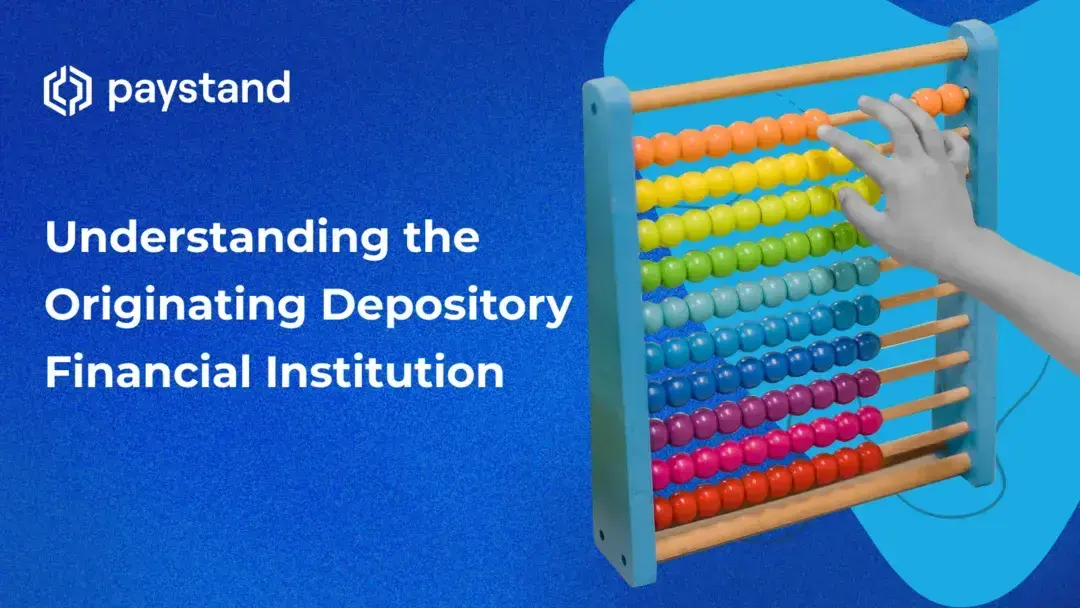Understanding the Originating Depository Financial Institution

Table of Contents
- What is an originating depository financial institution (ODFI)?
- What are the two most common types of depository institutions?
- How does an ODFI work?
- What is a receiving depository financial institution (RDFI)?
- The future of digital payments and ODFIs
Key Takeaways
- An Originating Depository Financial Institution (ODFI) initiates ACH transactions, connects originators with the ACH network, and ensures compliance with NACHA rules.
- Commercial banks and credit unions are the primary depository institutions with distinct profit and fee structures.
- An ODFI oversees ACH transaction processing, managing returns, and sending files to ACH operators for further processing.
- Receiving Depository Financial Institutions (RDFIs) receive and post ACH entries, handling credits and debits according to NACHA rules.
In the evolving landscape of digital payments, the role of an Originating Depository Financial Institution is pivotal. It provides the foundation for secure and efficient transactions across the ACH network. They act as intermediaries between businesses and the Federal Reserve to make payments smooth and safe.
Through regulatory oversight and a focus on data security, ODFIs uphold crucial standards that benefit businesses and consumers alike. If you’re intrigued by how ODFIs and ACH payments shape today’s digital economy, keep reading to uncover everything about these essential financial conduits.
What is an Originating Depository Financial Institution (ODFI)?
An Originating Depository Financial Institution (ODFI) is essential within the Automated Clearing House (ACH) network. It is the connection point between the network, the Federal Reserve, and the transaction originator.
The ODFI’s role begins with initiating the ACH transaction on behalf of the originator, ensuring that each transaction adheres to the standards and rules established by the National Automated Clearing House Association (NACHA). To fulfill this role, an ODFI must secure prior authorization for each account transaction, protect the security of ACH data, and uphold contractual agreements with each originator.
What Are the Benefits of Using a Depository Institution?
There are many benefits to using a depository institution, including:
- Safety: Depository institutions are regulated by government agencies to ensure they are safe and sound. This helps to protect depositors' money.
- Convenience: Depository institutions offer a wide range of financial services, making it easy for customers to manage their finances in one place.
- Affordability: Depository institutions typically offer competitive rates on loans and other financial products.
- Customer service: Depository institutions typically offer excellent customer service, making it easy for customers to get the help they need.
How Are Depository Institutions Regulated?
Government agencies regulate depository institutions to ensure their safety and soundness. Federal Deposit Insurance Corporation (FDIC) and the National Credit Union Administration (NCUA) are the main government agencies that regulate depository institutions.
- The FDIC insures deposits up to $250,000 at commercial banks and credit unions. This insurance helps protect depositors' money if a depository institution fails.
- The NCUA insures deposits up to $250,000 at credit unions and regulates them to ensure their safety and soundness.
What Are the Two Most Common Types of Depository Institutions?
Depository institutions are financial institutions that accept deposits from the public and offer various financial services. The two most common types of depository institutions are:
- Commercial banks: They are for-profit institutions that shareholders own and offer various financial services, including checking and savings accounts, loans, and investment products.
- Credit unions: these are member-owned, not-for-profit financial institutions that offer many of the same services as commercial banks. However, credit unions typically have lower fees and interest rates than commercial banks.
How Does an ODFI Work?
An ODFI oversees the processing of ACH transactions. Here’s how it works:
-
If an ACH return occurs, funds can’t be collected or deposited into the recipient’s account, much like a bounced check.
-
The ODFI collaborates with ACH originators to reduce risks associated with ACH returns and to maintain control over payment processing.
-
A business ACH originator (often a payment provider) submits ACH files to the ODFI, which then sends these files to the ACH operator (typically the Electronic Payments Network or the Federal Reserve).
-
The ACH operator processes these files, enabling deposits to be transferred to the Receiving Depository Financial Institution (RDFI).
What is a Receiving Depository Financial Institution (RDFI)?
A Receiving Depository Financial Institution (RDFI) is responsible for receiving and processing ACH entries, whether credit or debit, from the ACH operator (either the Federal Reserve or the Electronic Payments Network).
RDFIs post payments to customers' accounts according to NACHA regulations, ensuring timely and accurate processing of ACH entries. They handle return codes for issues like insufficient funds. RDFIs are not required to be ODFIs, but ODFIs must be capable of being RDFIs.
ODFI vs. RDFI: Key Differences and Similarities
| ODFI | RDFI | |
|---|---|---|
| Role in ACH Process | Initiates ACH transactions on behalf of the originator and submits them to the ACH network. | Receives and processes ACH transactions, posting payments to customers’ accounts. |
| Primary Responsibilities | Ensures transaction compliance, data security, and authorization; manages return codes. | Validates transaction data, manages accurate posting and handles return codes. |
| Relationship with ACH | Partners with ACH operators to send payment files. | Partners with ACH operators to receive payment entries. |
| NACHA Compliance | Must follow NACHA rules and maintain a low rate of ACH returns. | Must follow NACHA rules, accurately post entries, and inform originators of issues. |
| Similarities | Both must follow NACHA standards, maintain relationships with ACH operators, and play critical roles in processing and securing ACH customer payments. | |
The Future of Digital Payments and ODFIs
A well-chosen ODFI is more than just a processor; it’s a partner that ensures security, compliance, and reliability in your digital payment flows. For ACH originators, working with an ODFI that upholds NACHA standards and efficiently processes ACH payments can reduce payment risks and enhance transaction accuracy, ultimately supporting smooth business operations.
With Paystand’s B2B Network, businesses can simplify their ACH payments and tap into a scalable, fee-less payment infrastructure designed for modern financial operations. Discover how Paystand can elevate your payment strategy—download our free ebook on digital payments in the supply chain and unlock new efficiencies in your payment processes today.






